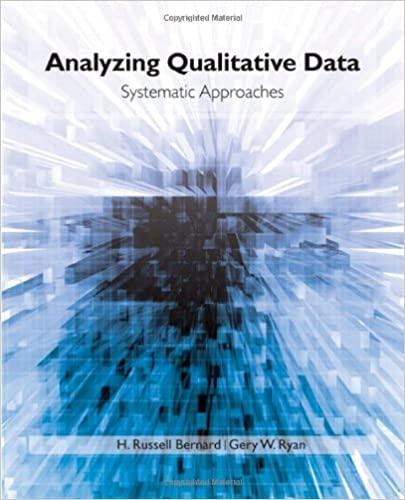Answered step by step
Verified Expert Solution
Question
1 Approved Answer
Is there adequate justification for the criticisms described? Do the areas of concern need to be addressed? Why or why not? Are there signs of
Is there adequate justification for the criticisms described? Do the areas of concern need to be addressed? Why or why not? Are there signs of progress in addressing some concerns surrounding practice in applied behavior analysis? Comment on post There is extensive research on the positive and negative side effects of the clinical work of Lovaas and the Young Autism Project (YAP). Some researchers argued that the YAP program was formulaic, a one-size-fits all therapy for children. However, Leaf et al., (2022) noted that this claim seems to be related to a misconception about the Lovaas Sridharan and the YAP. Individualization was critical and rigid protocols were anti-ethical to responding to the "unique" and "ever-changing" needs of a child (p. 2841). Secondly, a concern about Lovaas is he used electric shocks to stop children from engaging in obsessive and repetitive behaviors. Lovaas used electric shock as part of the intervention in his practice during the 1960's. However, electric shock was not used to prevent the repetitive and obsessive behaviors, but it was used to address the life-threatening self-injurious behaviors. Some autism rights and neurodiversity activities expressed concerns addressing stereotypic behavior within ABA-based interventions. Some argued that stimming helps decrease anxiety and stress for indivudal's with autism. Others stated stimming is a comforting and self-soothing behavior to reduce stress. Concerns about stereotypic and self-stimulatory behavior often involve claims that behavior analysts do not understand why individuals with ASD engage in these behaviors. Another claim involves behavior analysts targeting stereotypic behavior is abusive (Leaf et al., 2022, p. 2843). By the 1970's electric shock was replaced with spank. Lovaas implemented spank at the YAP in the early 1970's as a form of punishment procedure. Leaf et al., (2022) stated that some autism right and neurodiversity activists expressed concern that the use of punishment-based methods within interventions is inhumane and harmful (p. 2843). Unfortunately, the field of ABA adopted the term punishment, because to the general public, punishment has various connotations including retribution and pain. Similarly, to reinforcement, punishment is a naturally occurring principle of behavior. The field of ABA has history of using and researching punishment-based procedures. Since the early days, practitioners have decreased the dependence on using punishment-based procedures and preferred reinforcement-based procedures (Leaf et al., 2022, p. 2843). The Professional and Ethical Compliance Code for Behavior Analysts requires "exhausting the use of reinforcement procedures before the use of punishment-based procedures" (Behavior Analyst Certification Board, 2014). Some agencies and clinicians refuse to use any punishment-based procedures while other agencies implement non-invasive punishment-based procedures (e.g., removal of preferred items). The possibility of side effects is likely a reason why autism rights and neurodiversity activists expressed concern to the use of any form of punishment-based procedures (Leaf et al., 2022, p. 2843). Beaulieu et al., (2019) strongly encourages the behavior-analytic community to take cultural variables into consideration when delivering behavior-analytic services. Beaulieu et al., (2019) encourages researchers to evaluate the role of culture in behavior and best practices for delivering "culturally commitment behavior-analytic services" (p.575). Training on working with clients from diverse backgrounds is necessary from degree programs and continuing education providers. Connors et al., (2019) stated that future directions for clinical practice and training suggest improving diversity training in graduate school and during fieldwork and supervision (p. 775). This could improve the academic curriculum to develop cultural competency of behavior analysts. References Beaulieu, L., Addington, J., & Almeida, D. (2019). Behavior Analysts' Training and Practices Regarding Cultural Diversity: the Case for Culturally Competent Care. Behavior Analysis in Practice, 12(3), 557-575. https://doi.org/10.1007/s40617-018-00313-6 Conners, B., Johnson, A., Duarte, J., Murriky, R., & Marks, K. (2019). Future Directions of Training and Fieldwork in Diversity Issues in Applied Behavior Analysis. Behavior Analysis in Practice, 12(4), 767-776. https://doi.org/10.1007/s40617-019-00349-2 Leaf, J. B., Cihon, J. H., Leaf, R., McEachin, J., Liu, N., Russell, N., Unumb, L., Shapiro, S., & Khosrowshahi, D. (2022). Concerns About ABA-Based Intervention: An Evaluation and Recommendations. Journal of Autism & Developmental Disorders, 52(6), 2838-2853. https://doi.org/10.1007/s10803-021-05137-y
Step by Step Solution
There are 3 Steps involved in it
Step: 1

Get Instant Access to Expert-Tailored Solutions
See step-by-step solutions with expert insights and AI powered tools for academic success
Step: 2

Step: 3

Ace Your Homework with AI
Get the answers you need in no time with our AI-driven, step-by-step assistance
Get Started


